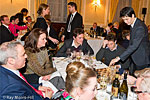
The Simul at Simpson's
Simpson's-in-the-Strand is one of London's oldest traditional English restaurants,
which was known as the Grand Cigar Divan when it opened in 1828. It developed
from a smoking room to a coffee house, and finally achieved dual fame for its
traditional English food, particularly roast meats and as the most important
venue in Britain for chess in the nineteenth century.
In the 19th century Simpson's was the Wimbledon of chess. Almost all the top
players visited the restaurant, including Wilhelm Steinitz, Paul Morphy, Emanuel
Lasker, Johannes Zukertort (who had a fatal stroke while playing there), and
Siegbert Tarrasch. It was in Simpson's in 1851 that one of the world's great
games, the famous "Immortal Game", was played between Adolf Anderssen
and Lionel Kieseritzky.

The Grand Divan, where Anderssen won his "Immortal Game" against Kieseritzky

The entrance of Simpsons-in-the-Strand in London today

Dinner after the London Chess Classic 2010 with over a dozen tables
Each table has a chessboard, and during dinner the participants of the Classic
move around, one at a time, to play against the guests at the table.
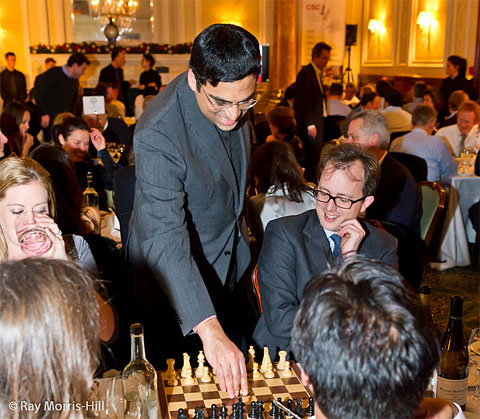
World Champion Viswanathan Anand opens with 1.d4 on one of the tables

Here David Howell makes his move at the sponsor's table, which includes
GMs Garry Kasparov and David Norwood. Kasparov restricted his advice to an occasional
smile or nod of the head. In the background on the right Malcolm Pein comments
on the games.

Hikaru Nakamura makes his move
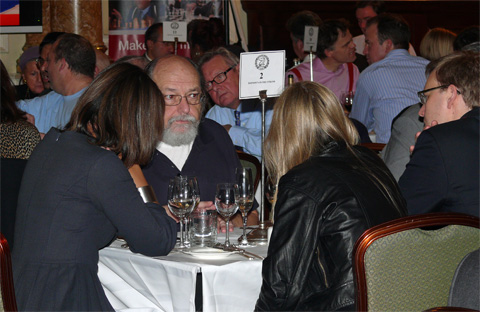
On table two Ken Thompson (of Unix and C fame) thankfully recorded the moves
Ken was with journalists from the BBC and other London media organisations,
and essentially played the following game by himself – "with some
help from GM Raymond Keene, who kept me from making any terrible blunders."
In the following gamescore he has noted which master made which move (VA = Vishy
Anand, HN = Hikaru Nakamura, NS = Nigel Short... You can guess the rest).
Chess Classic GMs - Keene, Thompson [B00]
Simpson's Simul, 15.12.2010
1.e4 VA 1...Nc6 2.f4 HN 2...d5 3.e5 NS 3...Bf5 4.Nf3
DH 4...e6 5.Bb5 LM 5...Nge7 6.d3 MA 6...a6 7.Ba4 VK
7...b5 8.Bb3 HN 8...Na5 9.Be3 NS 9...Nec6 10.Nbd2 LM 10...Be7
11.0-0 NS 11...0-0 12.a3 MC 12...Qd7 13.Qe1 DH 13...Rae8
14.Qf2 NS 14...Nb7 15.Ba2 VA 15...h6 16.Nb3 MA 16...f6
17.Qg3 LM 17...fxe5 18.fxe5 DH 18...Kh8 19.Rae1 VA 19...Bh7
20.Bb1 MC 20...Rf7 21.c3 MA 21...Ref8 22.d4 HN 22...Bxb1
23.Rxb1 NS 23...Nba5 24.Nc1 MC 24...Nc4 25.Qe1 DH 25...N6a5
26.Nd3 MC 26...Nxe3 27.Qxe3 DH 27...Nc4 28.Qe2 LM 28...a5
1/2-1/2. [Click to
replay]
The table that lasted the longest and the game that generated the greatest
interest was one that is described very nicely in Michael
Adams' new chess blog:

Simpson’s Simul Swindle
One of the nice touches at the London Classic is the simultaneous display that
accompanies the closing dinner: all the participants give a tandem simul making
one move each in turn, which leads to a happy kind of chaos.
The event is quite competitive as several of the boards (each having four players
consulting) have on their team a GM, including Speelman, King, Rowson, Norwood,
Watson, Keene and several other handy players; last year the tournament participants
had a fairly heavy loss. Chess players are quite competitive, and this year
we were paying a bit more attention (whilst making sure not to miss out on their
Yorkshire pud and glasses of claret). Malcolm Pein gave a running commentary
on the mic; eventually he announced that the score was even at 8 all with just
1 game remaining.

At this stage Magnus took over the game, a not unwelcome development that I
wouldn’t have minded availing myself of on a few other occasions. Still
the game seemed destined for a draw as there were only queens and a few pawns
remaining, the Black players were the presidents of three federations: CJ de
Mooi of the ECF, Tomas Sielicki of the Polish Federation, Viktor Kapustin of
the Ukraine Federation and Frederic Friedel of ChessBase fame, who had put up
stiff resistance in a Stonewall Dutch.
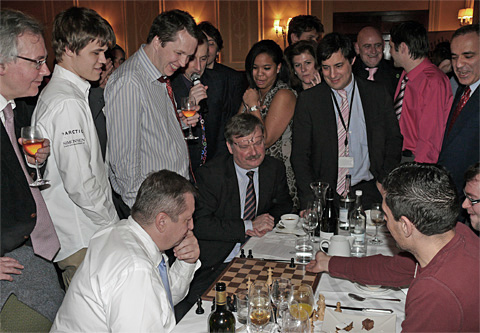
Magnus has just nudged his king forward to h4, a move which contained a rather
vicious trap.
Chess Classic Participants - CJ DeMooi et al
Simpsons LCC Simul, 2010.12.15
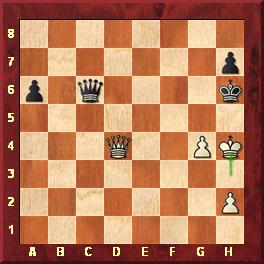
1...Qg6. After 1...Kg6 perpetual check would be inevitable,
although the queen move leaves Black's king gasping for air it is spectacularly
unfortunate that it loses immediately. 2.Qe5. This centralization
is amazingly powerful, it's highly surprising that with so little material remaining
the threat of g4-g5+ can't be adequately met, for example: 2...Qg8
[2...Qb6 3.Qg5#] 3.Qf6+ Qg6 4.g5# 1-0. [Click
to replay]

Michael Adams, England's perennial number one, with Garry Kasparov
Photos by Ray
Morris-Hill, Frederic Friedel
